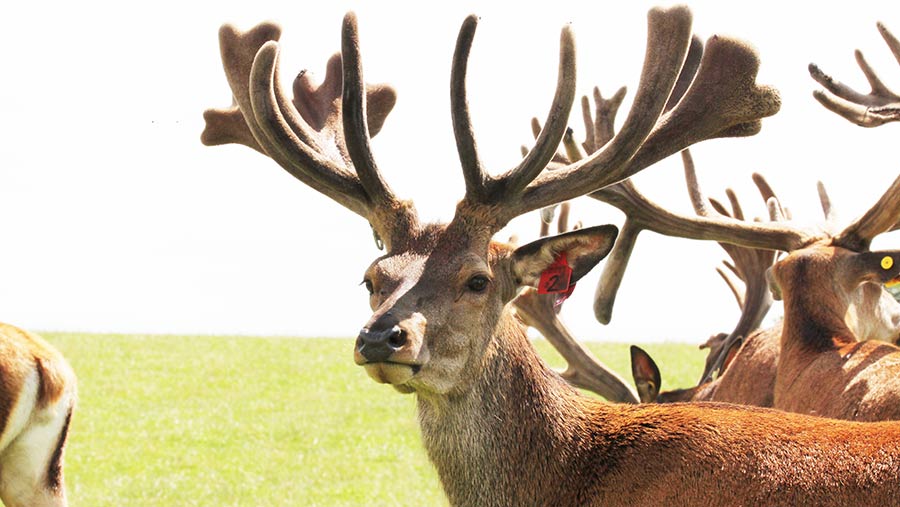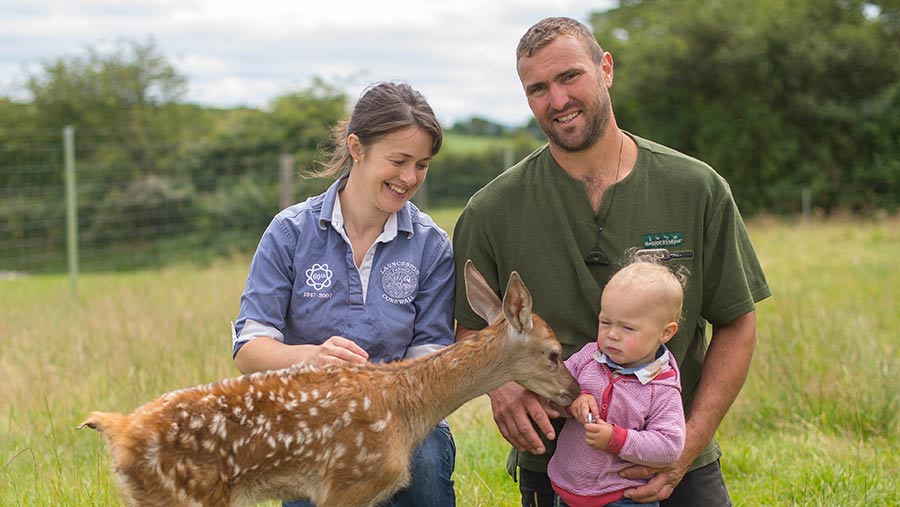What does it cost to set up a deer enterprise?
 © Red Oak Genetics
© Red Oak Genetics With venison being one of the few red meats seeing consumption grow in the UK, rising numbers of livestock farmers are looking into setting up a deer enterprise.
Venison prices of £5-£6/kg are one of the main attractions to new entrants into the industry.
However, fencing costs, health and safety and a lack of knowledge are considerable barriers stopping people getting into deer farming.
British Deer Farms and Parks Association (BDFPA) training officer Deidre Dyer, explains what is required to set up a 200-hind deer enterprise on 48.5ha of lowland pasture.
“There is growing interest in deer farming but you must do your homework before getting started,” says Mrs Dyer.
“Sourcing breeding stock is very difficult and handling systems, fences and gates represent a significant outlay.”
See also: Case study – How Aussie inspiration became a Devon deer farming success
What can fencing cost?
Fencing can with be with wooden or steel posts but it must be 1.9-2m high. Recently, deer farmers have fenced 11ha (five fields) for £6,000 with wooden stakes.
Savings can be made by being economical with strainer posts, doing erection work yourself and adding to existing fencing, “topping up” internal field boundaries.
Steel fencing can be guaranteed to last longer (30 years) and can cost £10-£15/m including labour. Erecting steel fencing yourself can bring the cost down to below £6/m for materials.
How many deer can I run on my farm?
A broad rule of thumb is one red deer hind eats as much as two large ewes. Upland improved pasture receiving 200kg of nitrogen and occasional lime should support 10-12 hinds and their calves a hectare from May to November or 15-18 yearling stags a hectare.
Lowland pasture under the same programme should manage 12-16 hinds a hectare with calves from April to November or 18-22 yearling stags.
Can I winter/finish deer inside?
Yes. Farms in the North or in exposed areas often winter calves and often hinds. Feed barriers and shed gates should all be at least 2m high.
Suggested floor areas and trough space for red deer |
||
|
Weight |
Area |
Trough length per head (ad-lib/rationed) |
|
Weaned calves 25-30kg |
1.5sq m |
15cm/22cm |
|
Calves 5-11 months 50-90kg |
2sq m |
20cm/30cm |
|
Yearlings/adults |
3sq m |
38cm/50cm |
What does breeding stock cost?
Deer are rising in price due to interest from new breeders. This is one of the main challenges in setting up a deer enterprise. Yearling hinds are about the £400 mark and mature hinds can cost £500. Stags cost about £1,500, with two-year olds at £2,500.
What is the cost of keeping deer?
Variable costs (excluding, for example, labour, utilities and machinery) and including buying in silage are about £2.70-£3.20/kg. Injectable and oral wormers, trace element and copper boluses and salt and mineral blocks leave an annual health budget of £18 a hind (including youngstock and stags).
Feeding is mainly grass and forage-based, although a typical concentrate feeding system will require 18t/year of concentrate for wintering stags and growing calves and finishing calves at a cost of £18 a hind.
What breeds are there?
British deer farming typically centres around the red deer as a maternal starting point, with European strains from Hungary, Poland and Romania added for an F1 cross, hybrid vigour and a slightly bigger carcass.
Wapiti stags can then be used to increase size and carcass weights even more, although as you breed for size you tend to lose prolificacy and hardiness.
How much is a carcass worth?
A 55kg carcass killing out at 50% and graded on the Europ grid at £5.40/kg is worth £297.
Red deer and F1 animals might average 51kg but aim for 55-60kg. In a bad year, they might be nearer the 45kg mark. Wapiti stags can add more frame and lean muscle into your stock and give a 65-70kg carcass.
What performance should I expect?
Pure English deer calves can be weaned at about 52kg, with a 25% increase expected for hybrids. A two-year old stag can serve 40 hinds and an older one can serve 60.
Deer have a 228-day gestation period. Growth rates of 200-250g/day can be expected to 115-135kg liveweight at 14 months. Start with low expectations about production, aiming for 60% calving rate but you should expect 70% calving rates on a yearling group, with good mature hinds to give you 85% or more.
What management do antlers need?
Stag testosterone levels increase through August ahead of the October rutting season, making males more likely to be aggressive and dangerous. Some de-antler stags as soon as the antler is hard. It is best to get an experienced deer farmer to do this the first few years.
How can I stay safe around deer?
Raceways and pens funnelling deer into handling systems need to be boarded up. If they can see the outside they will try and make a break for it so obscure the views with plywood.
Handling systems can be designed with multiple gates so a gate is always between you and the stag. Pens can have cages installed to step inside for protection and most deer farmers take a plywood shield with them.
Annual costs and gross margins: 10-year projection
- Costs to set up 200-hinds on a lowland farm.
- Culling hinds at seven years, buying stags at two years old and replacing them every four-to-five years.
- Wintering costs worked on buying silage (£42.50/bale) in and a beef-protein nut (£202/t).
- Fencing costs are for creosoted wooden posts erected by the farmer, not a contractor.
- Handling system uses a crush with a side door but no EID, electronic weigh-head equipment.
- Cost for minor adaptations to existing farm buildings not included.
- Does not include basic payment scheme or grant assistance.
|
Pros |
Cons |
|
|
‘Do it properly from the start’
Livestock Farmer Focus writers Matt and Pip Smith have almost halved sheep numbers to 800-head to build up a herd of 230 red/Romanian deer to diversify income in the hope of future-proofing their 121ha farm.
They started buying 60 yearling hinds and winding back the sheep numbers over an 18-month period, with the potential to build hind numbers up to 300-400-head or more.
About half the farm is deer fenced (64ha) with a further 20ha planned.
The Smiths’ philosophy has been to invest in quality steel fencing with a “buy cheap, buy twice” attitude, although money has been saved by reducing strainers from 4.5-5m intervals to 8m intervals and erecting the fence themselves.
Some fences were “topped up” with extra deer fencing and some fairly new fences were pulled up, with 12km of fencing erected in 11 weeks.

Pip and Matt Smith with their son Dusty © Jim Wileman
Complements the sheep
With the deer being strip-grazed on grass and herb leys and fodder beet, Matt says they complement the sheep well.
“At the start of April the sheep are lambed and then we can tighten the ewes up into a rotation and allow room for the deer to calve from mid-May,” explains Matt. “We already cell graze with the sheep and we are looking at doing this with the deer.”
Initial outlay
At £60,000, the Smiths believe they have a handling system that will keep staff and deer safe and allow money to be saved in the long run by working deer efficiently.
“If you are going to be paying vets £200/hour for specialised scanning and artificial insemination work then you want to be working 54 hinds in 90 minutes,” says Matt. “I can de-antler 38 spikers/hour on my own in the system we have.”
Trefranck handling system
- EID weight-crate: £4,500-£5,000
- Handling and sorting system supplied and erected for £60,000
- Hydraulic crush: £7,000-£14,000 depending on if it is second-hand or new
Find out more
The British Deer Farms and Parks Association is the industry organisation for venison producers.
It arranges courses around the UK on existing deer farms teaching introductory courses on deer faming offering training on deer health, management, de-antlering and culling.
